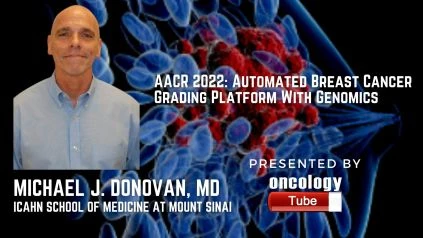Michael J. Donovan, MD, Ph.D., Research Professor of Pathology, Molecular, and Cell-Based Medicine at Icahn School of Medicine at Mount Sinai. In this video, he speaks about the AACR 2022 Abstract – 4145 / 8 – Novel approach that combines an automated breast cancer grading platform with genomics to personalize risk assessment and management.
Observation –
Origins:
The use of histology in determining breast cancer (BCA) clinical risk assignment, including stage, tumor size, and histologic grade, remains an important component of treatment selection and management. Recent studies have shown the value of combining these characteristics with genetic signals such as Oncotype and EndoPredict to enable precision risk assessment. Unfortunately, intra-pathologist BCA grading inconsistency continues to be a serious limiting factor.
Methodologies:
We analyzed a series of H&E pictures from patients with infiltrating ductal BCA using the Cancer Genome Atlas (TCGA) breast cancer (BCA) imaging collection, clinical and genomic data (i.e., EndoPredict and Oncotype), and clinical and genomic data (i.e., EndoPredict and Oncotype) (one slide per patient). A morphology feature array created from machine learning (ML) was utilized to standardize staining differences, detect tumor vs. normal regions, and characterize specific cellular properties such as tubule structure and organization, nuclear morphology, and mitotic figures. To determine feature relevance, individual features were connected with overall survival using the concordance index (c-index), support vector models, and Kaplan-Meier incidence curves.
Outcomes:
From 517 patients, ML-curated picture features reflecting BCA gland shape were produced, with 69 events (13%), 93 percent overall survival (OS), and a median follow-up of 5 years. Three clinical factors were evaluated: age, 59 years (median), AJCC stage T2 and 49 percent grade 3 and 41 percent grade 2, EndoPredict (EP) and an Onctoype (ONC) gene subset (PGR, ESR1, CCNB1, BIRC5, MYBL2, GRB7), and imaging characteristics. Age, stage, and ten imaging variables representing nuclear form, size, mitotic activity, lymphoid aggregation, and stromal content were chosen. Clinical + gene expression + imaging models produced C-indices of 0.84 (EP) and 0.82 (ONC), respectively, compared to clinical (0.79) and clinical + genomics models ( EP 0.81vs. ONC 0.79).
Observations:
A machine-learning platform beat grade and created accurate recurrence risk predictions, with clinical and genetic data showing added improvement. Future research will include larger cohort studies to confirm and expand on these findings.

